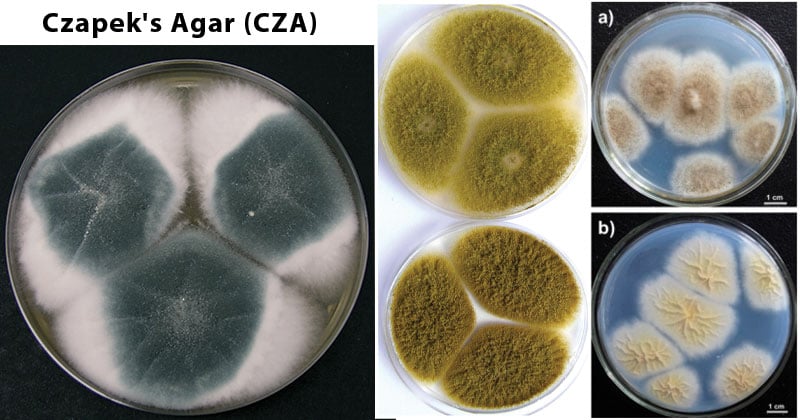- Czapek medium, also called Czapek’s agar (CZA) or Czapek-Dox medium, is a growth medium for propagating fungi and other organisms in a laboratory.
- It is recommended for use in qualitative procedures for the cultivation of saprophytic fungi, soil bacteria, and other microorganisms.
- The medium was originally developed by Czapek in 1902 for the cultivation of saprophytic fungi.
- Czapek-Dox Agar is a modification of the Czapek (1902-1903) and Dox (1910) formula prepared according to Thom and Church. The medium contains sucrose as the sole source of carbon and nitrate as the only inorganic source of nitrogen.

Interesting Science Videos
Composition of Czapek’s Agar (CZA)
| Ingredients | Gms/liter |
| Sucrose | 30.000 |
| Sodium nitrate | 2.000 |
| Dipotassium phosphate | 1.000 |
| Magnesium sulfate | 0.500 |
| Potassium chloride | 0.500 |
| Ferrous sulfate | 0.010 |
| Agar | 15.000 |
Final pH (at 25°C) 7.3±0.2
Principle of Czapek’s Agar (CZA)
Czapek Medium is a solid, neutral, chemically defined medium containing sodium nitrate as the sole source of nitrogen. Fungi and bacteria capable of utilizing this inorganic nitrogen source will grow. Sucrose is an energy source and the sole source of carbon. Dipotassium phosphate is a buffering agent, potassium chloride contains essential ions, and magnesium sulfate and ferrous sulfate are sources of cations.
Preparation and Method of Use of Czapek’s Agar (CZA)
- Suspend 49.01 grams in 1000 ml distilled water.
- Heat to boiling to dissolve the medium completely.
- Sterilize by autoclaving at 15 lbs pressure (121°C) for 15 minutes.
- Cool to 45-50°C.
- Mix well and pour into sterile Petri plates.
- Inoculate the material for testing by thinly spreading the sample on the surface of the agar medium.
- Incubate aerobically at 25-30°C for 1 to 2 weeks.
- Examine plate for growth at regular intervals.
- Subculture each colony type to appropriate media for isolation. Identify each colony type following established laboratory procedures.
Pour Tube: Melt the pour tube in a boiling water bath and cool to 45-50°C. Mix and dispense into a sterile petri dish and proceed with the instructions above.
Result Interpretation of Czapek’s Agar (CZA)
| Organisms | Growth |
| Aspergillus brasiliensis | Good growth |
| Candida albicans | Good growth; cream-colored colonies |
| Saccharomyces cerevisiae | Good growth |
| Aspergillus niger | White/yellow mycelium, black spores |
Uses of Czapek’s Agar (CZA)
- Czapek Dox Agar is recommended by APHA for isolation of Aspergillus, Penicillium, Paecilomyces and some other fungi with similar physiological requirements.
- Czapek Medium is recommended in Standard Methods for Examination of Water and Wastewater for use in the isolation of Aspergillus, Penicillium, and related fungi.
- The medium is widely used for taxonomic studies of Penicillium.
- Czapek Agar produces vigorous growth of nearly all saprophytic aspergilli and yields characteristic mycelia and conidia.
- The acidity of the medium may be increased for the cultivation of acidophilic organisms such as yeasts.
- The medium is useful in a variety of microbiological procedures, including fungi and mildew resistance tests and soil microbiology testing.
Limitations of Czapek’s Agar (CZA)
- This medium is a general purpose medium and may not support the growth of fastidious organisms.
- It is recommended that biochemical, immunological, molecular, or mass spectrometry testing be performed on colonies from pure culture for complete identification.
References
- http://www.himedialabs.com/TD/M075.pdf
- https://assets.thermofisher.com/TFS-Assets/LSG/manuals/IFU9322.pdf
- http://www.oxoid.com/uk/blue/prod_detail/prod_detail.asp?pr=CM0097
- American Public Health Association. Standard Methods for the Examination of Water and Wastewater,APHA, Washington, D.C.
- https://wiki.bugwood.org/Czapek_solution_agar

Would you send m SOP’s of this CZA
Please ,i need specific media to isolate Alternaria and Cladosporium from the air